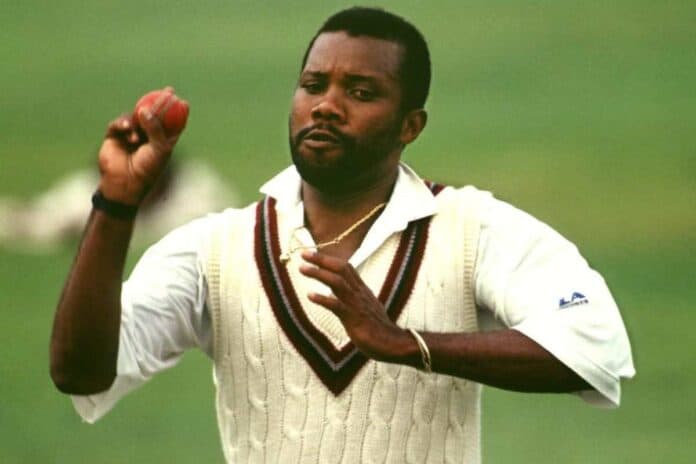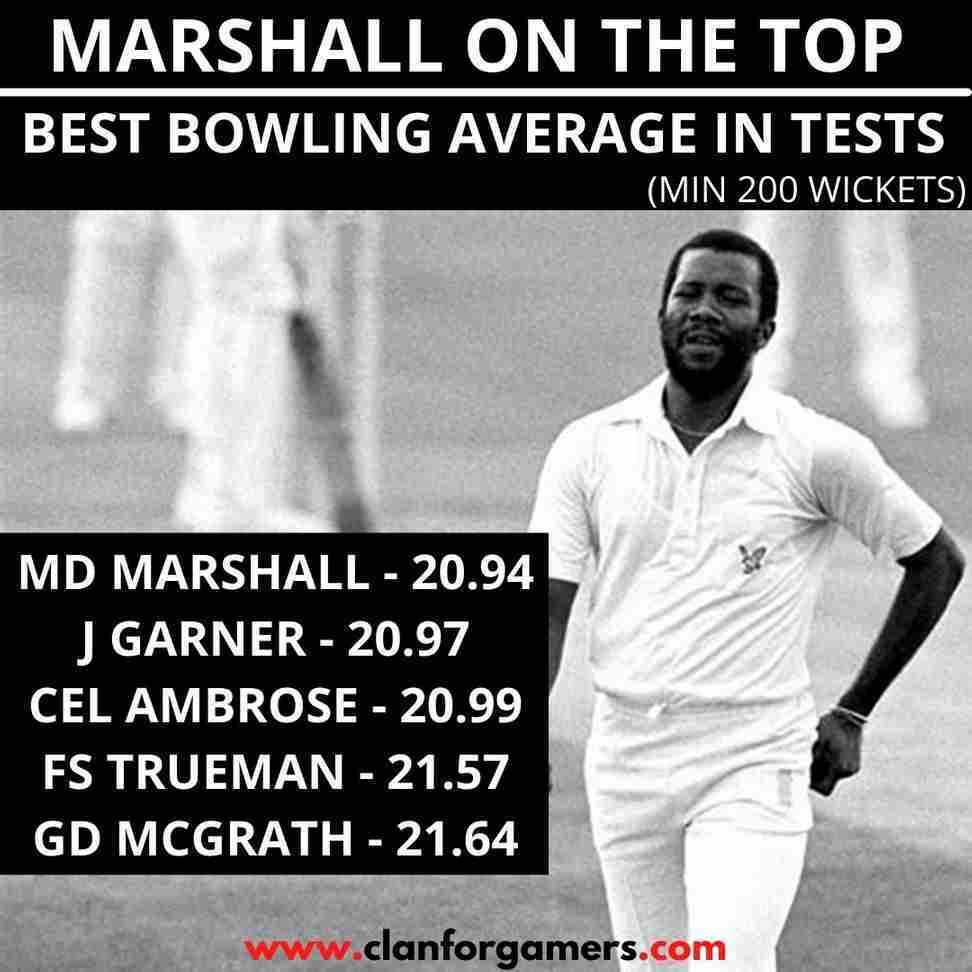No right-arm fast bowler took wizardry or biomechanics to as sublime heights as Malcolm Marshall, who could traverse surreal regions. His action was open and unorthodox, which did not please the purists, but no paceman better used the crease.
Marshall was the best-ever exponent of the skidding bouncer. He would defy the laws of biomechanics, with his deliveries doubling in speed after pitching. Batsmen were perplexed and could not gauge which way his deliveries would move, having the same action when moving the ball away or inwards.
Despite being diminutive in height, he more than compensated for it with his great bowling intelligence and slithering, skidding bounce. There were right-arm fast bowlers quicker and who moved the ball more, but none who could disguise it better than Malcolm.
Statistically, he was in terms of average, the best of the last half-century averaging 20.94 and in terms of strike rate, the best bowler of his time at 46.7.
No paceman had a greater percentage of wickets in games won, with 83% of his tests being winning ones. Above all, he was a colossus and stood out to contemporaries within the best pace attack ever.
Arguably no fast bowler outside the subcontinent displayed such mastery of craft on flat wickets in Asia. On unhelpful tracks which offered minimal pace or movement, his weapon was the short ball that snorted at the batsman. Marshall ended his test career with a tally of 376 wickets in 81 test matches.
A Glimpse of An Extraorindaty Career
When he made his debut in India, he looked pedestal amongst the best in the world but gave occasional flashes of brilliance. This trend continued in England in 1980 and Pakistan in the same year.
In 1982, at home against India, Marshall first showed his true metal when bamboozling the batsmen at Trinidad in the 2nd test and in the 4th test at Trinidad. In the 1983 world cup, Marshall tantalised opponents like none, topping his team’s bowling averages.
The 1983-84 tour of India saw Marshall as a virtual revelation who took dynamics of pace bowling in the sub-continent to heights rarely transcended. At Kanpur, his spell was reminiscent of a blitzkrieg storming, tormenting the Indian top order with his blistering pace and bounce. Marshall took the spirit of vengeance to a crescendo after West Indies lost the 1983 world cup final, resembling a military battalion avenging a defeat.
Rarely have I seen a pace bowler as fiery or send such tremors or shivers down the spine of opponents. He did not have a five-wicket haul in either inning but still bowled 2 of test cricket’s most lethal spells. He carried off where he left in later tests at Ahmedabad, Kolkata and Madras.
At Kolkata, with 6-37 in the 2nd Innings, he bamboozled the Indian batsmen to wrap up the series. He ended the series with a record 33 victims at an average of 18.93. To me, he was the most defining factor in the 3-0 triumph of the West Indies.
I have never seen a pace bowler sending the likes of Gavaskar, Amarnath and Vengsarkar literally hopping like Marshall. Few bowlers ever looked more like carrying a demolition operation.
In 1984 he continued his blazing trail in a home series against Australia, in England in 1984 and Australia in 1984/85. At Adelaide in 1984-85, he took fast bowling craft in unhelpful conditions to rarely explored regions, with certain deliveries to Wessels, Boon, Border and Jones worth preserving in a museum.
He was consistently personified in the home series against New Zealand in 1985 and England in 1986, as well as in the away and home series against Pakistan in 1986 and 1988.
In 1988 in England, while bowling at fast-medium, Marshall arguably bowled better than any overseas paceman on a test tour. When capturing 35 scalps at an average of 12.88, he looked like he was taking fast bowling biodynamics to another dimension.
No one ever blended pace, movement or control better with a surprise element. There were speedier pacemen or those who swung it more, but none took innovations to such surreal regions. Batsmen were perplexed by the changes in speed and variation in swing and bounce. His-7-22 at Old Trafford was one of Test cricket’s great spells.
In 1988-89 in Australia, although overshadowed by Curtly Ambrose, he was a demon at his best. On a flat turning track, he captured 5 wickets, like a surgeon curing a patient considered incurable. Allan Border was reminded of a magician that day.
Marshall was on top in a home series against India in 1989 but declined in form from 1990-91 and was sadly dropped for the 1992 World Cup in Australia. Regrettably, he was denied the opportunity of scaling the landmark of 400 test scalps.
Strangely Marshall was not at the top in One Day International Cricket, averaging over 26. He was overshadowed statistically by Garner, Roberts and Holding in average, strike rate and economy level.
He was quite an effective batsman and could well have become a genuine all-rounder. He Played some cavalier, match-turning knocks in his career, like scoring 92 at Kanpur in 1983-84, batting one-handed at Leeds in 1984, or 48 at Bridgetown in 1988 against Pakistan.
It is worth mentioning that Dennis Lillee played an important role in shaping Marshall’s career, teaching him the leg–cutter. Marshall emulated Lillee, probing deeper regions.
Is Malcolm Marshall The Greatest Ever Fast Bowler?
Marshall is a strong candidate for the title of the greatest test fast bowler or even the best fast bowler. Many cricketing experts award him that stature.
It could be said that Marshall may have had substantially more scalps as well as 5 and 10 wicket hauls, representing a weaker test team or bowling attacks, like Richard Hadlee or Kapil Dev. However, he may not have had as economical a bowling average or even strike rate.
In that light statistically to me, Richard Hadlee, considering the percentage of team wickets and weakness of attack representing, was the best-ever pace bowler.
Hadlee would be better on a green top, but in unhelpful conditions, Marshall would always come out on top. Curtly Ambrose being more accurate, was more lethal than Marshall on a fast or broken wicket but would not match Marshall on a flat pancake.
In recent times Dale Steyn was similar but could not bring the ball to move inwards like Marshall or as effective in disguising bounce and movement. Glenn Mcgrath had more control but did not possess Marshall’s versatility or aggression. Dennis Lillee and Andy Roberts were more classically complete but not as unpredictable or creative as Marshall. For sheer wizardry, Wasim Akram was arguably the only pace bowler who matched strides with Marshall.
Deservedly he is rated the best ever fast bowler in David Gower’s 50-best cricketers and in Geoff Armstrong’s 100-best cricketers. The latter even ranks him ahead of Sachin Tendulkar and Viv Richards as a cricketer. Cristopher Marin Jenkins ranks him at 11th place amongst the 100 best cricketers ahead of any genuinely quick bowler. In my view in test cricket, I could not choose between Sydney Barnes, Marshall and Lillee. Adding ODI’s, Marshall to me would just slip in behind Wasim Akram and Glenn Mcgrath.
There is a reason why the likes of Allan Border, Graham Gooch, Ravi Shastri, Alec Stewart, Geoff Boycott, David Gower and Dilip Vengsarakar rate him the best pace bowler they ever faced.



From his debut until about mid '83, Marshall had 55 wickets from 17 tests and in his last 3 years, he had 86 from 23. If you add the two up, that would mean 141 from 40 test. Which means, in the middle period, across 41 tests he picked 235 wickets! Should we read it as powerfully impactful at his peak but only decently good otherwise? Unlike perhaps a Lillee, Hadlee or Mcgrath? But what a champion bowler, skilful and deadly.